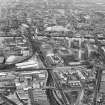Glasgow, Lauriston - Gorbals
General View (Period Unassigned)
Site Name Glasgow, Lauriston - Gorbals
Classification General View (Period Unassigned)
Canmore ID 70580
Site Number NS56SE 343
NGR NS 58 64
Datum OSGB36 - NGR
Permalink http://canmore.org.uk/site/70580
- Council Glasgow, City Of
- Parish Govan (City Of Glasgow)
- Former Region Strathclyde
- Former District City Of Glasgow
- Former County Lanarkshire
OLD GORBALS
Gorbals in the 1840s was such a hotbed of quarrels and disturbance that it became known as 'Little Ireland'. In the 1870s Glasgow City Improvement Trust demolished the old Gorbals village, Elphinstone's Tower and St Ninian's Chapel, building new tenements, designed by Alexander Thomson, around a new Gorbals Cross. They also provided a central clock tower and underground public toilets. Population had grown rapidly, reaching 40,000 in the combined areas by 1890 and, with the arrival of vast numbers of destitute immigrants, 'made down' or subdivided tenements became the norm, alongside 'back to back' building on back lands. The population in the 1930s reached 90,000. Redevelopment, following slum clearance in the 1960s, was not successful; much of that has also gone, and with it much of the population
HUTCHESONTOUN & NEW GORBALS
Hutchesontoun was the largest portion of the old Elphinstone Barony. Several streets were laid out to a feuing plan of 1793, the first buildings erected in St Ninian Street by the next year. Such severe restrictions were imposed on feuars that, in ten years, only five streets around the principal thoroughfare, Hospital Street, had buildings on them. Crown Street became the commercial centre, lined up with the new bridge in 1805, now replaced by Albert Bridge. In 1820, the Trustees changed their policy: abandoning ideas of grandeur, they now permitted mills and factories. By 1840, working-class flats were allowed within the four-storey stone tenements. Industry was also encouraged, later encroaching on much of the housing. The biggest works were Govan Iron Works, 1839 and the United City Bakeries Society at 12 McNeil Street, 1886. The New Gorbals, begun on site about 1990, continues to grow in this area, after the old names were blurred in the 1960s. Great enthusiasm has been shown by New Gorbals Housing Association tenants and house purchasers alike.
Taken from "Greater Glasgow: An Illustrated Architectural Guide", by Sam Small, 2008. Published by the Rutland Press http://www.rias.org.uk













